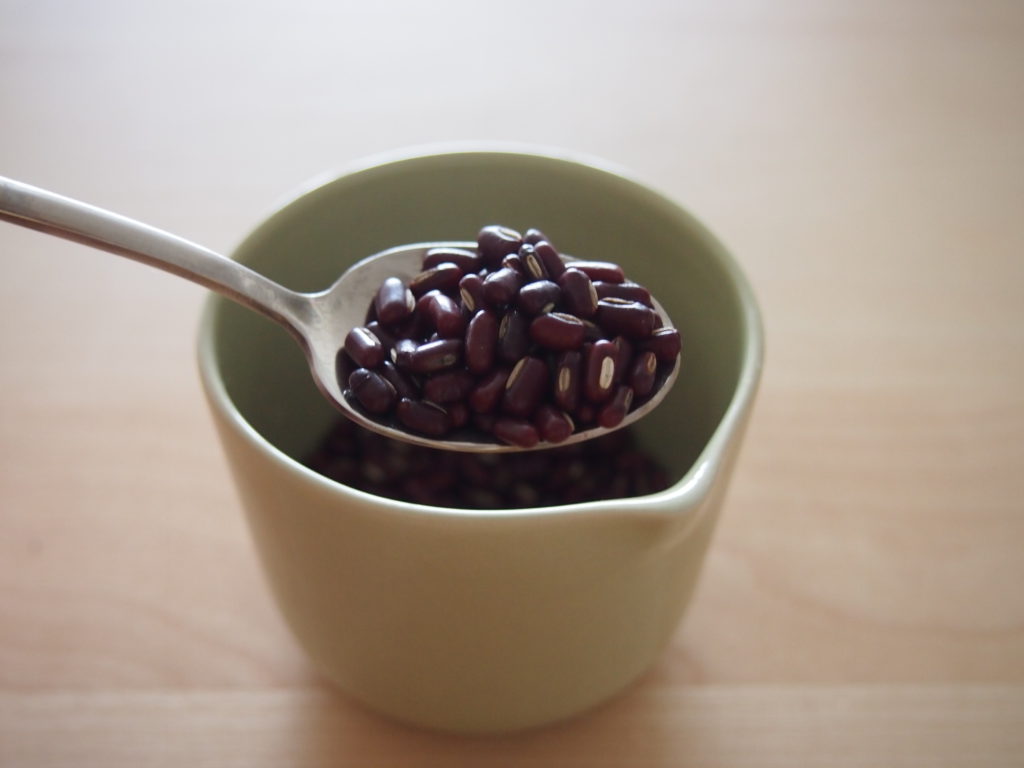- Scientific name: Vigna umbellata
- Mandarin Chinese: Chi Xiao Dou 赤小豆/飯豆
- English: Red rice bean
I know I have not been posting for a long time. That is because I have been away, trying to recover from a serious bout of migraine.
During this journey, I have discovered the red rice bean. This English name is not a formal one, as the bean is not really known to the English-speaking world. On Wikipedia, someone gave the name as a literal translation of the alternative Chinese name “rice bean” 飯豆, an allusion of its size.
Originally, I thought I was looking at red beans, which is a related but different species: Vigna angularis. Red beans are bigger than red rice beans, which are more the size of the green mung beans, which are Vigna radiata.
Be careful not to confuse the red rice bean with the red version of mung beans and the Japanese sub-species of the red bean called Azuki beans. First of all, red rice beans are deep red while red mung beans are dusty red. Azuki beans are shaped more like the roundish red beans while red rice beans are small but longish.

Benefits of red rice beans
Red beans have the highest antioxidant content of ALL FOODS. Previously berries were occupying that place but as they are relatively pricey, this information comes as good news for many people who try to consume antioxidants in your diet. As you may already know, antioxidants get rid of the harmful free radicals in your body, which if remain, causes immunodeficient diseases like flu and cancer.
In traditional Chinese medicine, the red rice bean has the best medicinal qualities of all beans.
16th century herbalist/physician Li Shizhen wrote this about the red rice bean:
“induces the production of good fluid, facilitate urination, reduces swelling, stops vomiting; To be used to treat diarrhoea, alcohol intoxication; Helps to get rid of the swellings of winter fires (寒热), stops pus and dilutes the blood, induces milk flow…”
You can buy these at a traditional Chinese pharmacy or if you are lucky in a Chinese supermarket.
Unlike all the beans mentioned above, red rice beans are not eaten and are considered as a medicine. It does not get mushy when cooked, unlike the red and mung beans.
To obtain its antioxidant goodness, add a tablespoonful of rice beans to half a pot of water (1 litre). Boil for 30 minutes until the water is completely red. Add some sugar if you like. Drink it as a tea.
Note: if your red rice beans lose colour when cooked, then you may have been cheated. It could then by dyed red mung beans.

Hello Harry , it would be very helpful it you can provide some links with organic red rice beans, i couldn’t find any , or maybe conventional red rice beans grown in the USA ? thank you very much !
Hello Mihai! I don’t live in the US, so I don’t really know. I haven’t seen it being sold online though. Normally, Chinese pharmacies or Chinese supermarkets would stock them. Do ask them by showing them the Chinese characters 赤小豆, as they may not know the English name. Good luck!
I buy it from wing fung hong store NY via ebay. Authentic red rice bean but not sure its organic. I soak overnight and boil the water. Multicolored rice beans are also available from nepali or rarely some indian stores. Its commonly eaten in the Indo himalayan tracts and interior south east asia. Red and black rice beans are highest in water soluble antioxidants.
Thank you for the store suggestion. The Chinese supermarket closest to me (in Queens, NY) has several brands of this “red rice bean”, but most have sulphur dioxide as a preservative. There is one brand that doesn’t state this, but I am doubt that it doesn’t have it.
It’s okay if it’s not organic. I simply don’t want that chemical in my medicine!
Thank you again and thank you, Harry, for your post.
It works well for light edema or water retention like tcm practioners say.
You said, “add a tablespoonful of rice beans to half a pot of water.” Would that be a 1.8 Liter Pot … or an 8.4 liter pot? Do you think you could be just a teensy-weensy more specific and what a “pot” equals, and maybe even specify the size that would be best?
Thanks!
Rick
Hi, thank you for your comment! Indeed, I should have been clearer! I’ve added the quantity of 1 litre to the article. Good luck!